Last year, Nassim Taleb posted this on Twitter:
For a correlation number between X and Y, what is the "half point" correlation between 0 and 1, that is, the correlation for which you have half the uncertainty about X if you observed Y ( or vice-versa) compared to not having observed Y?
The answer is apparently 0.87 (specifically, $\sqrt{3}/2)$, and it apparently comes from Equation (13) here:
Can anyone explain what is going on?
How is $\sqrt{3}/2$ derived? And what does it actually mean, intuitively?
